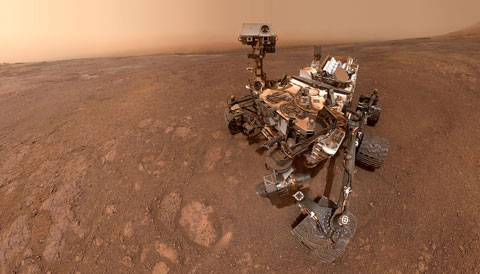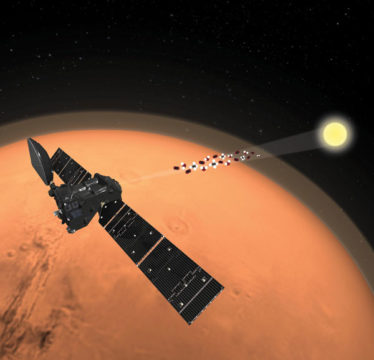Now you see it, now you don’t: The Curiosity rover on Mars detected the highest level of methane yet, but a follow-on experiment saw those levels recede within a week. Scientists are working to understand the significance of the result.

NASA / JPL-Caltech
On Monday, NASA announced that its Curiosity rover on Mars has detected the highest level of methane yet — 21 parts per billion by volume (ppbv). That’s about twice as high as the previous record. The announcement preceded NASA’s AbSciCon astrobiology conference in Belleview, Washington, where Paul Mahaffy, the principal investigator of the Sample Analysis at Mars (SAM) instrument aboard the rover, talked briefly about the new result.
The existence of methane is intriguing because of its potential biological origin, but it’s important to note that the gas may come from geological processes instead. Curiosity can only detect the gas, it can’t determine its origin.
But wait, there’s more: When SAM sniffed the air again, just days after the record-breaking whiff, the methane was gone. Levels had returned to background levels of about 1 ppbv. (If you take a unit of volume, one billionth of it would be methane.)
There’s been an ongoing controversy over methane in Martian air. Curiosity has detected spikes of methane during its time on the surface, although at other times it has reported methane levels near zero. Some of Curiosity’s methane spikes have been confirmed by orbital measurements from Mars Express. But the European Space Agency’s ExoMars Trace Gas Orbiter (TGO) has found no evidence of the gas, even during one of Curiosity’s spike.

ESA / ATG medialab
The discrepancy comes about in part because while Curiosity measures from perhaps a meter up from the ground, and Mars Express makes “nadir” measurements looking down at the ground through the atmosphere, TGO’s most sensitive instruments look sideways through the Martian atmosphere, to see how sunlight is aborbed. So TGO has a tough time seeing the air next to the surface — it’s really investigating the atmosphere at altitudes of 4 kilometers (2.5 miles) and higher.
The principal investigator of TGO’s Atmospheric Chemistry Suite, Oleg Korablev (Russian Academy of Sciences), confirms that TGO was taking methane measurements at the same time as Curiosity, but the most sensitive instruments weren’t making their measurements anywhere near Gale Crater. However, both TGO and Mars Express did make less sensitive “nadir” measurements, which are still being analyzed. In fact, some data are still onboard the spacecraft and have yet to be downlinked.
Based on the previous studies, Korablev suggests, “There are probably mechanisms at work, which destroy methane rapidly yet near the surface.” This new plume of methane that Curiosity detected, and its rapid disappearance, may shed some light on these mechanisms. But it’s really too soon to tell — there’s a lot more work to be done, starting with obtaining and analyzing all the data, before this study can be published in a peer-reviewed journal.
“This is very much an ongoing scientific study,” says Curiosity team member Christopher Webster (Jet Propulsion Laboratory).
 0
0









Comments
You must be logged in to post a comment.